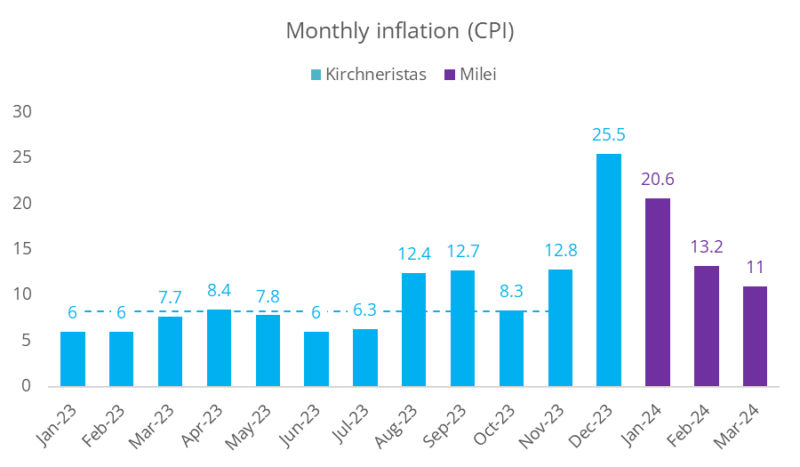Is Argentine Disinflation Sustainable?

With dollarization discarded in the short run, the world is eagerly watching Milei’s initial steps as the new president of Argentina. Milei took office in December with a yearly inflation rate of 211 percent (yes, you read that right). Despite the lack of robust monetary reform, Milei’s government managed to reduce the inflation rate and balance the budget for three consecutive months, capturing the attention of some international media. Will Argentina shock the world with an inflation miracle?
While the rapid improvement in fiscal and inflation numbers is undeniable, it is still too early to declare victory. It is far from obvious that the current situation is sustainable in the medium and long term. Let’s first examine the inflation numbers.
During the presidential campaign, candidate and Minister of Economics Sergio Massa proposed an aggressive expansionary policy – Plan Platita – to enhance his chances of winning the election. In Argentina, the lag between monetary shocks and the price level is significantly shorter than in the US, and Massa’s plan had an almost immediate impact on the price level. As shown in the figure below, the inflation rate rose to 25.5 percent in December. The average monthly inflation rate between December 2022 and November 2023 was 8.3 percent. Since Massa’s Plan Platita ceased after the presidential elections, the expectation is that the monthly inflation rate should return to pre-election levels. Milei’s government is balancing the budget, but the recent disinflation can be largely attributed to the expiration of Massa’s policies. Achieving further disinflation would require the monthly inflation rate to drop below 8.3% percent. Perhaps that will happen, but Argentina is not there yet.

The long-term success of Milei’s plan hinges on his ability to sustain fiscal surpluses. Fiscal surpluses were primarily achieved through cuts in government spending in the first three months of 2024. Most notably, the government is 1) delaying transfers to utility firms and provinces and 2) reducing the real value of transfers and pension payments to the private sector. The former reflects lower expenditures in the Treasury’s cash flow for now, but these payments will eventually resume. The latter effort may not be politically sustainable. More than half of the spending adjustment directly affects the private sector and, according to Empiria Consultores, the average salary in Argentina is now below the poverty line. How much longer can Milei maintain the adjustment before he loses popular support?
Argentina needs fiscal reform to reduce inflation. But those reform efforts must be credible. If the government cannot be expected to deliver surplus balances in the medium and long term, then its disinflation efforts also lack transparency and accountability over the same period. A lack of public belief in the project could jeopardize Milie’s stabilization plan.
The fiscal and inflation numbers have looked much better over the first three months of Milei’s government. A closer examination of how these numbers were achieved, however, raises concerns about their medium- and long-term sustainability. Milei cannot delay payments to utilities and provinces forever. He may not be able to maintain the real cuts made to transfers and pension payments, either. Furthermore, Milei’s lack of political support in Congress adds to the uncertainty surrounding his ability to successfully pass deregulatory reforms. For these reasons, it is premature to declare victory on the fiscal and inflationary fronts in Argentina.
The most efficient way out of this credibility dilemma is to announce a concrete monetary reform that would anchor expectations and provide a positive shock to the economy. Monetary reforms are quicker to implement (and show their effects faster) than other structural shifts, such as balancing the budget or a labor-market initiative. In turn, a credible monetary reform would facilitate the passing of other novel adaptations and allow for more consistent fiscal restraint measures and progress toward a stable, balanced budget.










